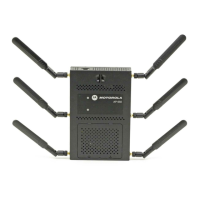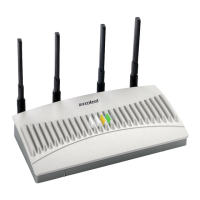Profile Configuration
7-19
8. Set the following profile WLAN Properties for the selected Access Point radio.
Data Rates Once the radio band is provided, the Data Rates drop-down menu populates
with rate options depending on the 2.4 or 5 GHz band selected. If the radio
band is set to Sensor or Detector, the Data Rates drop-down menu is not
enabled, as the rates are fixed and not user configurable. If 2.4 GHz is selected
as the radio band, select separate 802.11b, 802.11g and 802.11n rates and
define how they are used in combination. If 5 GHz is selected as the radio band,
select separate 802.11a and 802.11n rates then define how they are used
together. When using 802.11n (in either the 2.4 or 5 GHz band), Set a MCS
(modulation and coding scheme) in respect to the radio’s channel width and
guard interval. A MCS defines (based on RF channel conditions) an optimal
combination of 8 data rates, bonded channels, multiple spatial streams,
different guard intervals and modulation types. Clients can associate as long
as they support basic MCS (as well as non-11n basic rates).
Radio Placement Use the drop-down menu to specify whether the radio is located Indoors or
Outdoors. The placement should depend on the country of operation selected
and its regulatory domain requirements for radio emissions. The default
setting is Indoors.
Max Clients Use the spinner control to set a maximum permissible number of clients to
connect with this AP-6511 radio. The available range is between 1- 128.
Beacon Interval Set the interval between radio beacons in milliseconds (either 50, 100 or 200).
A beacon is a packet broadcast by adopted radios to keep the network
synchronized. Included in a beacon is information such as the WLAN service
area, the radio address, the broadcast destination addresses, a time stamp,
and indicators about traffic and delivery such as a DTIM. Increase the DTIM/
beacon settings (lengthening the time) to let nodes sleep longer and preserve
battery life. Decrease these settings (shortening the time) to support
streaming-multicast audio and video applications that are jitter-sensitive.The
default value is 100 milliseconds.
DTIM Interval BSSID Set a DTIM Interval to specify a period for Delivery Traffic Indication Messages
(DTIM). A DTIM is periodically included in a beacon frame transmitted from
adopted radios. The DTIM period determines how often the beacon contains a
DTIM, for example, 1 DTIM for every 10 beacons. The DTIM indicates
broadcast and multicast frames (buffered at the Access Port) are soon to arrive.
These are simple data frames that require no acknowledgement, so nodes
sometimes miss them. Increase the DTIM/ beacon settings (lengthening the
time) to let nodes sleep longer and preserve their battery life. Decrease these
settings (shortening the time) to support streaming multicast audio and video
applications that are jitter-sensitive.

